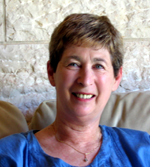By Dorothea Shefer-Vanson

LA CREUSE, France –The village where we are currently spending our summer is a place where almost all its inhabitants are either retired, absent or dead. The memorial plaque in the centre of the village commemorating those who died in the two world wars lists 37 names for WWI and 5 for WWII, which probably helps to explain why there are so few people living in rural France today.But two years ago the energetic mayor of the place set in motion a project intended to revive the fortunes of this backwater. In order to bring new life to the place he decided to liven up its twelfth century church (which has been extensively renovated in the centuries since then and currently presents a strange collage of kitsch and folk art) by introducing a revolutionary innovation: windows made of tapestry, the craft for which this region (dominated by Aubusson) is famous worldwide. Needless to say, no services have been held in the church for many years.
But this is no ordinary tapestry, because windows are supposed to let in light and the wool which constitutes most tapestries would not allow light to pass through. So these tapestries are made from anodized aluminium threads in various colours, a new technique which has only recently been developed. In addition, Jean Fourton, the artist who was commissioned to design the windows, decided to designate them as homage to Leonardo da Vinci, whom the French regard as their adopted son (he died in the arms of his protector, King Francis I). The most notable feature of the windows is, however, that whether by accident or design, they can’t be seen from inside the church, only from the outside.
More than 100 people attended the ceremony held in the church Saturday evening, July 21, to inaugurate the windows, each of which represents in semi-abstact form one of the concepts on which Leonardo da Vinci worked — the human form (DNA), a flying machine (first man on the moon), canals (water), etc. The programme included one hour of arias, both sacred and operatic, sung by some very talented local music students, accompanied at the piano by their teacher, Josee Carlosema. However, the first song, which was sung by Carlosema herself and was not listed on the programme, was in Yiddish! The audience listened attentively, but I doubted that anyone other than myself and my husband knew what it was.
After the extensive and lengthy speeches by the mayor and the various participants in the project, not to mention the visiting dignitaries from the region (8 in all), I went up to Carlosema and asked her what the song was called and why she had chosen to sing it. The song was ‘Zi darf es azoy zein’ (imagine hearing that in a church!) and she said that she sang it to commemorate all those Jews of France who were deported to concentration camps at the time of the Nazi occupation. While I was talking to her the artist whose work we were inaugurating came up to thank her for the music, and in particular for her first song which, he said, ‘brought tears to my eyes.’ Yes, he was Jewish, too. It’s a small Jewish world, it seems, even in a church in la Creuse.
*
Shefer-Vanson, a freelance writer and translator based in Mevasseret Zion, can be reached at dorothea@shefer.com This article initially appeared on her blog, http://fromdorothea.wordpress.com